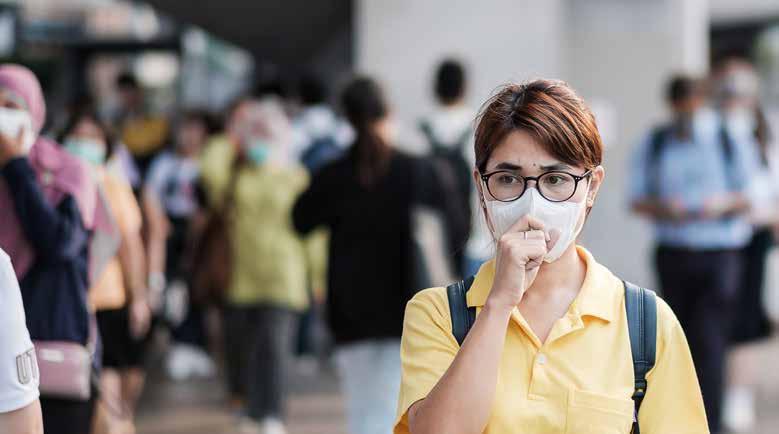
20 minute read
Death, disruption and
Death, disruption and the student supply strain
The novel coronavirus has infected the global education sector. In this special report, Josh O’Neill offers a thorough assessment of the wide-ranging symptoms and shares strategic prescriptions that could help alleviate operational and financial pains
Viruses and business are not a good mix.
We’ve all been here. You’re sitting at your desk in the office, in close quarters with colleagues, when someone starts coughing violently. The germophobe within immediately cries out. If the offender is by your side, you might shuffle away from them, wrinkle your nose and furrow your brow in disapproval/disgust. Hypochondriacs may reach for sanitising gel or slip on a face mask. But all efforts to guard immune systems are in vain. In the end, the infection spreads like spilt coffee on a desk, leaving some office serfs sniffling at their workstations while leading others to self-quarantine on a work-from-home basis or take sick leave.
Viruses are successful at what they do because of their innate ability to mutate rapidly. Businesses, on the other hand, are not the most agile of beings. In the scenario outlined above, consider a sick member of staff who doesn’t have a laptop and thus cannot work from home. Or, they may not have remote access to essential servers or CRM systems. Perhaps the person lives with their parents, who haven’t an adequate space in which they can work, or simply don’t want them lingering around during the day. All too real are such circumstances, particularly for SMEs.
This year’s outbreak of the novel coronavirus – or COVID-19, to use its official name – has spawned a worldwide work-from-home experiment of unparalleled scale. In an educational context, the black swan has triggered a mass experiment in online learning of similar proportions.
What is speculated to have begun life in January as a never-before-seen viral strain at an animal market in Wuhan, China, has rapidly transformed into an epidemic that has shut down cities, crippled businesses and curbed international travel. As we go to print, the respiratory virus – for which there is currently no vaccine – has crossed six continents, infected over 83,000 people and killed nearly 3,000 – and counting. In response, businesses are being forced to change tack abruptly and develop workarounds, the most obvious of which is remote working.
Institutions of all stripes have been disrupted as the virus has metastasised across countries and industries within them. In the UK, several GP surgeries have been shut down. Hong Kong’s flagship airline, Cathay Pacific, asked its staff to take three weeks’ unpaid leave. Formula One’s Chinese Grand Prix has been postponed. Sporting events have been cancelled. Organisers of this year’s Olympic Games, to be held in Tokyo this summer, have cast serious doubt on whether they will run to schedule. Conferences are being culled across the globe. There are endless examples, but the point is this: not every line of labour or activity can be carried out online.
Providers of education – discounting online specialists – have come to realise this amid their efforts to fend off infection by transitioning to online provision. For the global education sector, the symptoms of the coronavirus outbreak are acutely painful in the short – to potentially medium – term, for several reasons. ▶



First, providers of face-to-face education often lack the strategic agility and flexible infrastructures that enable remote learning and working during times of tumult (hence substitute teachers’ existence). Moreover, in-person interaction is not merely a nicety but an imperative in some instances – when teaching special needs students, for example.
Second, a great many institutions across the world make a lot of money by educating or enrolling pupils from farflung countries, with China being by far and away the largest feeder of international students. At present, a large number of flights into and out of China are cancelled. The timing of the outbreak has exacerbated this particular problem. The virus began to spread over the Lunar New Year – one of China’s most important holidays – for which natives often return home. It is likely that those who did so have since been unable to leave to return to their overseas studies. (More on this particularly thorny issue later.)
Third, schools and other educational centres – filled with youngsters with undeveloped immune systems and relatively poor hygiene habits – are ideal breeding grounds for viruses. Keeping doors open in danger zones is to sign a reputational death warrant – not to mention potentially illegal.
Fourth, education of all varieties tends to be paid for in advance. If one has shelled out on a service that was ultimately not delivered, then one may seek a refund or reimbursement. From a provider’s perspective, handing back fees is essentially a loss of revenue – and could cause cash flow issues later down the line.
There are two lenses through which one should look to assess the coronavirus’s impact on education: Chinese and global. We’ll begin with China-related issues before exploring problems pertaining to education markets outside the mainland.
Large portions of China’s education market, which is valued at around $300 billion, are effectively at a standstill. Public and private schools and nurseries are all closed across the mainland least mid-March. With more than 500,000 schools, 260 million students and 15 million teachers, China is home to the world’s largest education system.
Hong Kong’s international schools, which along with state schools and kindergartens are not permitted to re-open until at least 20 April, are bracing for financial headwinds, with some warning that they might have to close permanently. Their concerns were relayed to Hong Kong’s chief executive, Carrie Lam, in a letter written by the French and British chambers of commerce. It reads: “If the specific needs of international schools cannot be rapidly addressed, this will very likely trigger decisions of families (not just expatriates) to leave Hong Kong in the coming weeks. This would also have dramatic consequences on the international schools’ financial position, even to the point of putting at risk the continued operation of some.”
This development comes at a time of protracted turmoil in Hong Kong, where chaotic riots and violent clashes between police and protestors over the past eight months have prompted many foreign families to flee, piling further pressure on the city’s international schools. Mark Schaub, partner at China-focused legal firm King & Wood Mallesons, says “we foresee a much-reduced number of foreign students in China” and Hong Kong. “Overall, our assessment is that it will take at least a year to normalise.” ▶ Schools’ major concerns are around staff – will existing talent want to stay, and will they be able to recruit new teachers
Julian Fisher, Venture Education


Mark Schaub, King & Wood Mallesons
This year, 16 new offshoots of British independent schools are set to open in China, joining the 17 established brands which collectively run 36 schools in the country, according to Venture Education, a consultancy. However, in light of the coronavirus outbreak, projects have been put on ice. “Construction sites are currently at a standstill, so there will be very real challenges in terms of infrastructure, but also in relation to licensing and other paperworkrelated issues,” Julian Fisher, senior partner at Venture Education, tells this publication.
To be sure, established schools are facing tough times, too, as the transition to online delivery has proved tricky. “Schools have been forced to move everything online and tout its success, but the reality is that most schools have not done this before and their understanding of online teaching is limited,” says Fisher. “Teachers are hurriedly familiarising themselves with new platforms.” The majority of schools are offering online education “in one form or another”, according to ISC Research. For instance, Wellington College International Shanghai is trialling a virtual-learning platform and its teachers are producing short video lessons for students. “Meanwhile, parents of children in schools across China are grumbling that they are now having to do all the work and that dumping tasks” – setting basic homework assignments via rudimentary online portals – “is not an effective way to teach their children.”
In a letter to parents, David Ingram, headmaster of Dulwich College Shanghai Minhang, acknowledged that “the issue of instability and slow download speeds” have “frustrated” fee-paying families. Their qualms are understandable, considering so-called tiger parents shell out up to £35,000 a year for private schooling at Dulwich. According to Fisher, “younger students and exam-year students” – A-Level exams begin in two months – “are particularly badly affected, as online activities are no replacement for the necessary human interaction or ability to motivate and respond to students’ individual needs”.
Chinese networks are bound to stringent laws prohibiting material deemed to be lewd or politically insensitive, and punishments for breaching China’s internet rules range from account freezes to jail time. But official censors can be overly sensitive. In vignettes posted online, several teachers say they have been temporarily excluded from streaming platforms for various infringements. In one instance, an obstetrics and gynaecology teacher was blocked for using “bad language”, but “realised it was probably because I was describing genital anatomy”.
Listed Chinese school groups’ share prices mirror the hardship and uncertain times that they’re facing. On 17 February, Bright Scholar, Maple Leaf and Wisdom Education were down 7%, 10% and 11%, respectively, from a month prior. Similarly, Chinese pre-school operator RYB Education was down 10% on the same date. A fall in Chinese students may weaken rental growth and directlet occupancy ▶

Students in China seeking an educational human touch are, at present, largely unable to get it – even outside the classroom. After-school tuition centres, which in China and Hong Kong make up a $64 billion industry according to Frost & Sullivan, are also out of action. Yet movements in the share prices of after-school tuition providers do not depict a tale of outright hardship – volatility has been short-lived and contained within narrow windows. Between 16 January – days after the first known death from the disease was reported – and 24 January, TAL Education and New Oriental, China’s largest listed tuition providers, tumbled 17% and 13%, respectively, before recovering to yearto-date highs. These relatively mild price dips – and subsequent bounce-backs – can be explained, in part, by their expanding online channels. In its 2019 annual report, TAL said sales from its online courses accounted for 17% of total revenues, up from 7% in 2018 and 4.7% in 2017, illustrating the evergrowing importance of digital channels in the tuition sector. (It is worth noting, though, that online tuition costs up to 50% less – and thus produces slimmer margins than classroom-based teaching.)
However, independent centre-based tuition providers, which operate to thinner margins and thus haven’t the infrastructure nor spare capital to implement a breakneck shift to online provision, will be hard hit by the plunge in footfall.
It’s not only students and shareholders who are suffering as a result of all this. Teachers’ careers have been thrown into a temporary state of flux as travel bans prevent foreign teaching staff from re-entering China, never mind returning to school. Their employers, meanwhile, are unable to tell them when they’ll be allowed back in the classroom because the Chinese government can’t say when, exactly, they’ll be permitted to re-enter the country. While staff members’ salaries are for the most part unaffected, it can be difficult to get by on a Chinese teaching wage in expensive cities like Sydney, London and New York, where many English-speaking staff hail from. One teacher residing in Australia who works for a school in Hangzhou tells this publication via LinkedIn: “I want to get back to work. Staying in Australia is damn expensive. The school can’t give us a firm date; every time they do it changes.”
The position that foreign teachers have been put in is causing Venture Education’s China-based international school clients to fret about future recruitment, at a time when there is a chronic shortage of teaching staff across the world. Fisher says: “Schools’ major concerns are around staff – will existing talent want to stay, and will they be able to recruit new teachers.”
China has responded to adversity in typical grandiose fashion. In mid-February, some 200 million children resumed studies online after the government established ▶ Current challenges are likely to refocus the conversation on revenue diversification opportunities



7,000 servers, each capable of hosting 50 million users at a time. For those in remote areas without internet access, some lessons are broadcasted on state TV channels. But although the scale of such an operation is unequivocally impressive – especially so, given the short window of time within which it was built – the consensus among teachers online is pessimistic. In a LinkedIn post, Malcolm Harrison, headmaster of JKFZ Cambridge International School in Jiangxi, says: “Tools that allow for active learning and continuous formative assessment are not really available at present”, adding that “it would be so much simpler” if platforms such as Google Classrooms, Nearpod and Kahoot! could be accessed. Alas, they can’t, due to China’s rigorous restrictions on foreign content.
An educational epidemic As we can see, the problems that the coronavirus outbreak has caused for China’s education sector are significant and wide-reaching. But what about the rest of the world’s education markets? Suffice it to say, China’s seismic influence on global trade and economies is allencompassing; education operators and service providers to them across the world are feeling reverberations.
As mentioned earlier, China is the world’s largest exporter of international students. In 2018, the year for which the most recent figures are available, some 662,000 Chinese pupils embarked on studies overseas, according to the Beijing Overseas-Study Service Association (BOSSA). There are millions of Chinese nationals enrolled in foreign studies, ranging from boarding schooling in the UK, through to pathway courses and university degrees in Australia.

Australia’s education market – the nation’s third-largest export – is heavily reliant on revenues from Chinese nationals, who collectively make up a A$15 billion (£7.7 billion) student cohort. The country’s university sector is over-exposed, several experts have warned, with around 10% of all students coming from China – comprising almost half of the overall international student body. Most (60%) study at Go8 institutions, the country’s top-eight universities. The University of Sydney, for example, collected A$500 million in fees from Chinese students in 2017 – accounting for onefifth of its total annual revenues.
It is unsurprising, therefore, that the tertiary sector Down Under is feeling the pinch of travel bans to and from China imposed by the Australian government. At the time of writing, Australia had extended its travel ban to 22 February. More than half of some 200,000 Chinese students at Australia’s universities, most of whom spend upwards of A$30,000 a year on tuition, have been unable to resume their studies because of their ineligibility to re-enter the country. Meanwhile, a recently published report by BOSSA states that between 40% and 60% of Chinese students have been “directly affected” in overseas university and visa applications. China’s Ministry of Education cancelled all English-proficiency exams scheduled for February; as a result, BOSSA’s report says, 35% of Chinese students had “incomplete materials” for their applications.
According to Standard & Poor’s, this places up to $3.1 billion in tuition fees at risk. In turn, universities’ credit profiles are also in jeopardy, should the outbreak fail to stabilise by April, the ratings agency has said. “The health crisis underscores the risks that stem from the sector’s growing dependence on the lucrative international market,” says S&P. It has been reported that some students are transferring to institutions in Europe and the US. The Australian Global Reputation Task Force says that enrolments and revenue could be reduced by as much as 30% due to COVID-19.
A number of universities have responded to the coronavirus crisis by delaying the semester’s official start date from 24 February to as late as 30 March and offering online tuition in the meantime. But China’s stringent national firewall can impede cross-border online education, points out Anip Sharma, partner at L.E.K. Consulting’s global education practice. “Universities are having to negotiate with the great firewall of China – not everything can get through,” he says. Universities have reportedly called on Beijing to relax online barriers. “Plus, it takes a time and resources to create online content – and even then, the solution could be sub-optimal. It is usually hard for a year one undergraduate international student to access content often in a new language without support,” he adds. “Online solutions aren’t necessarily readily available or easy to deploy.” In a testament to this notion, the University of New South Wales advised its students stuck in China to defer studies until June instead of offering online classes.
Sharma notes that the outbreak has come at a crunch time for the higher education sector. “This is the peak of the intake cycle for Australian universities,” he says. “They can’t enrol new [Chinese] students, nor can they re-enrol existing students who haven’t returned from Lunar New Year celebrations.” ▶
At the very least, according to Sharma, Australian universities will incur increased costs linked to additional support services, exam re-sits and extended timetables. In the worst-case scenario, the outbreak will continue throughout the first semester, at the end of which tuition fee revenues could be irrecoverable. “Ultimately, the timeframe is crucial,” he says. “If this continues for a while, then semester one revenues could be lost.” A report by Nikkei Asian Review claims that some students may have to delay graduating for a year because certain compulsory courses are only available in the first semester. ▶
Homes under the hammer Students stuck in China are more than likely required to keep paying rent on their student digs abroad, in countries such as the UK and Australia, even if they’re empty. While this is obviously a bad situation for student tenants, it might sound like good news for accommodation providers, which are effectively being paid for vacant rooms. This is not necessarily the case.
Scape, Australia’s biggest student accommodation provider, says that around 85% of its portfolio is booked, but that around a quarter of those bookings, or students, are yet to arrive due to travel bans. Typically, the firm will contend with around 50 cancellations across its portfolio of properties; this number has risen to 100 in light of the coronavirus outbreak. Scape is waiving fees for affected students until the travel ban is lifted.
Meanwhile in the UK, analysts at Berenberg, the investment bank, point out in a February note that “a fall in Chinese students may weaken rental growth and direct-let occupancy in 2020/21” – otherwise known as the knock-on effect. “With the potential for a material reduction in Chinese students for the academic year 2020/21, we think there is scope for some occupancy and

rental-growth headwinds,” write analysts, noting that, out of publicly listed student accommodation providers in the UK, “GCP and Empiric have the largest exposures” to Chinese student bodies. Conversely, London-listed Unite Students, which as the UK’s largest student accommodation provider controls 22% of the market, “remains the best-insulated and our top pick in purpose-built student accommodation”, analysts say. “Unite has the least potential exposure to the coronavirus.”
Unite was up 4.5% month-to-date on 18 February; GCP was down 6% over the same period, while Empiric had remained flat. But short-term share price movements are perhaps an inaccurate precursor of future financial performance, because any potential revenue losses are yet to be realised. As Sharma puts it: “Again, it comes back to the time-frame; if this continues for several months, then student accommodation providers could incur irreversible revenue losses.”
Other subsectors of the UK’s education market are facing complications and financial pressures, too.
There are nearly 13,000 Chinese nationals in UK independent schools, accounting for 44% of all overseas students. The vast majority are in boarding schools, with parents living in China or elsewhere. At the time of writing, half-term is underway. While the UK has not imposed an outright ban on travel to China, its government has advised “against all but essential travel” to the mainland. Therefore, Chinese students who had wished to return home over half-term are unable to do so.
Vicky Wilson, senior associate in the education practice of Wilsons, a private client law firm, stresses that schools “must ensure alternative arrangements are made” for students whose legal guardians are unable to look after them over the half-term. “Schools should consider whether they should keep their boarding houses open and staffed,” says Wilson.


This, of course, means additional costs at a time when many single-site private schools are operating to paperthin margins. “This is likely to be less of an administrative burden than arranging alternative guardianship for a large number of pupils at very short notice.” The Boarding Schools’ Association goes a step further, advising its members to “put this in place for all pupils from Southeast Asia”, while stressing that “schools must proactively plan ahead for Easter”, in case the situation remains unchanged or worse. From bad comes good Disruption wields the power to move markets, and often does so in a positive way in the long run. But before things get better, they are likely to get worse – at least in the short term – as the coronavirus continues to run riot, day by day infecting thousands more people and claiming hundreds more lives. Over the four days it took to construct this article, the number of infections practically doubled, while the virus claimed an additional 1,000 lives.
Certain educational sub-sectors, such as private schools and higher education, are resilient during downturns and will almost certainly be able to weather the storm – albeit with operational and financial hiccups along the way. But for independent, centre-based education providers in China, the prognosis could be bleak. The SARS outbreak of 2003 stress-tested small, unorganised education providers, many of which didn’t survive. A similar story could play out over the coming months, should the COVID-19 crisis fail to be quickly quelled.
While there is no strategic antidote, there are operational medicines that education providers can in the meantime swallow to alleviate symptoms and enhance performance. Indeed, you might even say there are even silver linings.
Experts are sanguine about the opportunity to test out new online solutions and galvanise existing ones at a time when education consumers, in many cases, have no choice but to use them. In fact, TAL launched its first online programmes in the aftermath of the SARS epidemic. Education providers – school groups, universities and tuition businesses alike – should recognise the “opportunity to build brand along with large bases of consumers”, says Sharma. Shanghaibased iTutorGroup says the number of online classes taken on its platforms was three-times more than the previous year during the first ten days of February. Citigroup analyst Mark Li says that two million Chinese students have enrolled in short-term online classes.
“This could be a watershed moment for online education,” says Sharma. “We could see a boost in adoption levels as people who were late adopters or sceptics sample online solutions and become more receptive.
“Providers that do a good job will be remembered by students, and this in turn will build trust and create a positive brand image.”
Where universities are concerned, the situation should serve as a wakeup call to institutions that are over-reliant on income from Chinese students, and give impetus to revenue diversification plays. “Current challenges are likely to refocus the conversation on revenue diversification opportunities, even those beyond international students, like transnational and online education,” says Sharma. “Should the current situation recover soon, universities would be well served to avoid the temptation to go back to business as usual.”
“After all, today it is the coronavirus. Tomorrow, it could be something else.” n












